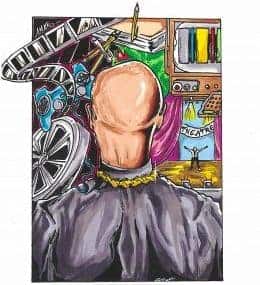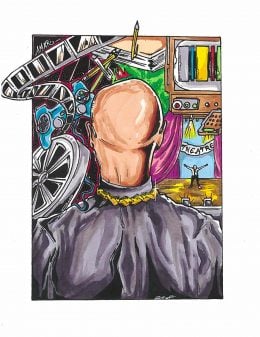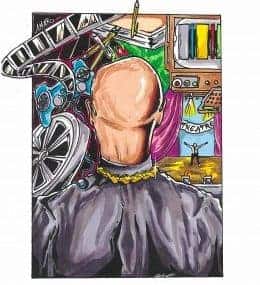The Trans List – Overview/ Review (with Spoilers)
Overview/ Review (with Spoilers) The Trans List, in many ways, seems like the thereafter or “Where Are They Now” sequel to Laverne Cox’s The T Word. For with each struggle as a child, teen or young adult, you have this person who made it. They sometimes aren’t 100% sure how, but here they are. Alive,…

Spoiler Alert: This summary and review contains spoilers.
Additionally, some images and text may include affiliate links, meaning we may earn a commission or receive products if you make a purchase.

Overview/ Review (with Spoilers)
The Trans List, in many ways, seems like the thereafter or “Where Are They Now” sequel to Laverne Cox’s The T Word. For with each struggle as a child, teen or young adult, you have this person who made it. They sometimes aren’t 100% sure how, but here they are. Alive, living, and for the most part, happy. Thus giving hope to those who question or know that no matter the path you may take, there is a rainbow after the storm.
Characters & Storyline
A shared experience. That is what it means to be trans for this group of individuals. However, like the story in Fade, while they all share one basic thing, their own journey is complicated and can be massively different from one another. In the documentary, you have those who are middle-aged, if not old, as well as those who are you. There are those who are activist like Bamby Salcedo and then there is a porn star like Buck Angel. Each of these people have lived through periods of trauma because of their identity, and some made it through even without the safety net of family. Thus creating not just a documentary which highlights these figures, but shows there are many paths to reach some form of self-acclimation.
Collected Quote(s)
We are a constellation of experiences, expressions, and identities. Ours is a mesmerizing constellation, so vast it can’t be contained, so plentiful it can’t be denied, so brilliant, it shines through the dark.
I’ve never regretted my surgery. It was important for me. I do know and have heard of people where, ‘It’s gonna make me a woman.” You know, ‘I can’t wait!’ And it’s like no, it’ll help you function, but it’s never gonna make you a complete woman. That’s just a small part of the whole picture.
I always refer to myself as ‘Yo soy un milagro,’ which means that I am a miracle. There was a reason why I didn’t get killed when I was on the streets. There was a reason why when I overdosed in an alley, the paramedics came and got me. There was a reason why I didn’t get killed when I was in prison. I’m supposed to be here doing what I’m supposed to be doing.
I know it just seems very… shallow in a sense, but I think for trans people, our outer selves are very important to us. They’re very important to the way we present to the world because it’s the way the world comes back to us.
Becoming connected to your sexuality and your body sexually is a huge part of becoming yourself, and understanding and loving your body, it changes everything.
I can act, I can wear the clothes, I’m comfortable in my womanhood. But what does that really mean? What is this thing ‘female’ I still struggle with that. It’s more than hair and makeup. It’s more than the pitch of your voice. I didn’t grow up having my first period. I didn’t grow up on my first date. I didn’t have all of these things that all women experience. I am a trans women. My experience is different and I think I am different than other women, and I never want to disrespect women from that standpoint, but I’m much more comfortable over on that side, and that’s the first time in my life I can ever say that.
Highlights
Different Background and Perspectives
I’m very big on diversity and especially happy to see diversity when it comes to groups which aren’t considered part of the mainstream. For how else are you going to find “your tribe,” as Shonda Rhimes would put it, if you didn’t have access to seeing them, hearing them, or reading their stories? Which was the beauty of this documentary not just featuring young people, but also those in their 50s and beyond. For, with that, you get reminded there was a time before the internet, before any answers you wanted was a search away or you could find communities, be it online of physical, with some sort of ease. Which, as you surely could imagine, meant life was even more difficult.
After all, what doctor in the 60s, 70s, 80s, or even 90s, knew what to do with someone trans? According to some of the speakers, often you were relegated to perhaps being gay and that in itself is shown as something complicated. I mean, just think about it. Where is that line between thinking you are just femme or masculine and realizing that actually you were born into the wrong body? This wasn’t the choice you made when you decided to come to Earth.
Also, I loved Alok Vaid-Menon noting that before western colonization, there were a lot of societies which didn’t subjugate or look down on Trans people. In Hindu culture, even the Gods switched how they identified. So who are the people to judge someone who wishes to be femme one day, masculine the next, or decides that despite being born one gender, they feel the need and desire to become the other. If not straddle the imaginary line.
The Possibility and Complications of Starting Over When Trans
But one of the thing which really made me think was how some of the participants were able to almost start over after they transitioned. The two prime examples are Caroline Cossey and Caitlyn Jenner. Caroline transitioned during a time before the internet, but when tabloids still existed. So while fine with keeping her past a secret till the grave, especially since she was fish, unfortunately, she was outed.
Then with Caitlyn Jenner, while her transition was highly public, there comes that interesting tidbit that she transitioned later in life. Unlike many in the program, she didn’t begin as a kid, teenager, or when she was a younger adult. She had kids, marriages, and then transitioned. So comes the topic of, what do your kids call you know? They’ve known you as their father their whole life but now are you mommy 2? Then, on top of that, while the kids knew who you were, your grandkids didn’t. So you get a chance to really start over for, in someone’s eyes, you were born the way you felt you should have been. Which was such a jarring thing to think about. These men, women, and those non-binary crafted a new life and sort of a new person. All the while, trying to get society to understand that old Maya Angelou quote of “When someone shows you who they are, believe them.”
On The Fence
Showing The Before Pictures
While I understand fully, part of this documentaries’ purpose is showing it gets better and there isn’t just one path or way to get to a better place, I must admit I found it uncomfortable to see the pictures pre-transition. To me, before and after pictures almost seem weirdly inappropriate. Now, granted, I’m not trans so who am I to say, but I feel that putting them out there gives people ammunition. It is a tool which could be used to invalidate. However, at the same time, part of each person’s journey includes who they were at one time. Something they can’t deny, all the time, and have to learn to reconcile with. Not because they need to or have to, but because if it wasn’t for the things that person was exposed to and what they learned, would they have ever found their purpose? Would they have found and cultivated the person who survived the journey?
Overall: Positive (Watch It)
I don’t want to say “I feel enlightened,” but I must admit that the more I seek out LGBT productions, I more and more realize the power of media. As noted by a Vox video, “people do learn from film and television whether you want them to or not.” And being exposed to something normalized it. Which is why I loved this film. Often times, when it comes to LGBT media, what is normalized is whiteness. An FTM or MTF white person.
Yet, with seeing Black, Hispanic, Native American, and those who just don’t identify with a gender, just imagine what that does for a kid. Take note of what characters like GI Joe, Pee Wee Herman, and others did for those who spoke. They gave them an idea, a goal to obtain, and with seeing someone like that accepted, they were able to reconcile complicated feelings and realize their thoughts and feelings were valid. They weren’t strange because they weren’t the first to feel a certain way, look a certain way or want to look a certain way. There was someone who paved a path already and they just have to be brave enough to stand in their truth and walk that road.
Hence why this is marked Positive. For those who may think they are trans, they get shown all the various lives and paths they can take, no matter what they look like or what their socio-economic background. Then, for those who may not question or feel firmly cis, you get to understand what those who don’t feel and think like you went through. Thus normalizing them, humanizing them, and stripping them of that “Other” label. For, at the end of the day, they are Janet, Shane, Caitlyn, Nicole, Amos, Caroline, Bamby, Buck or Miss Major.

